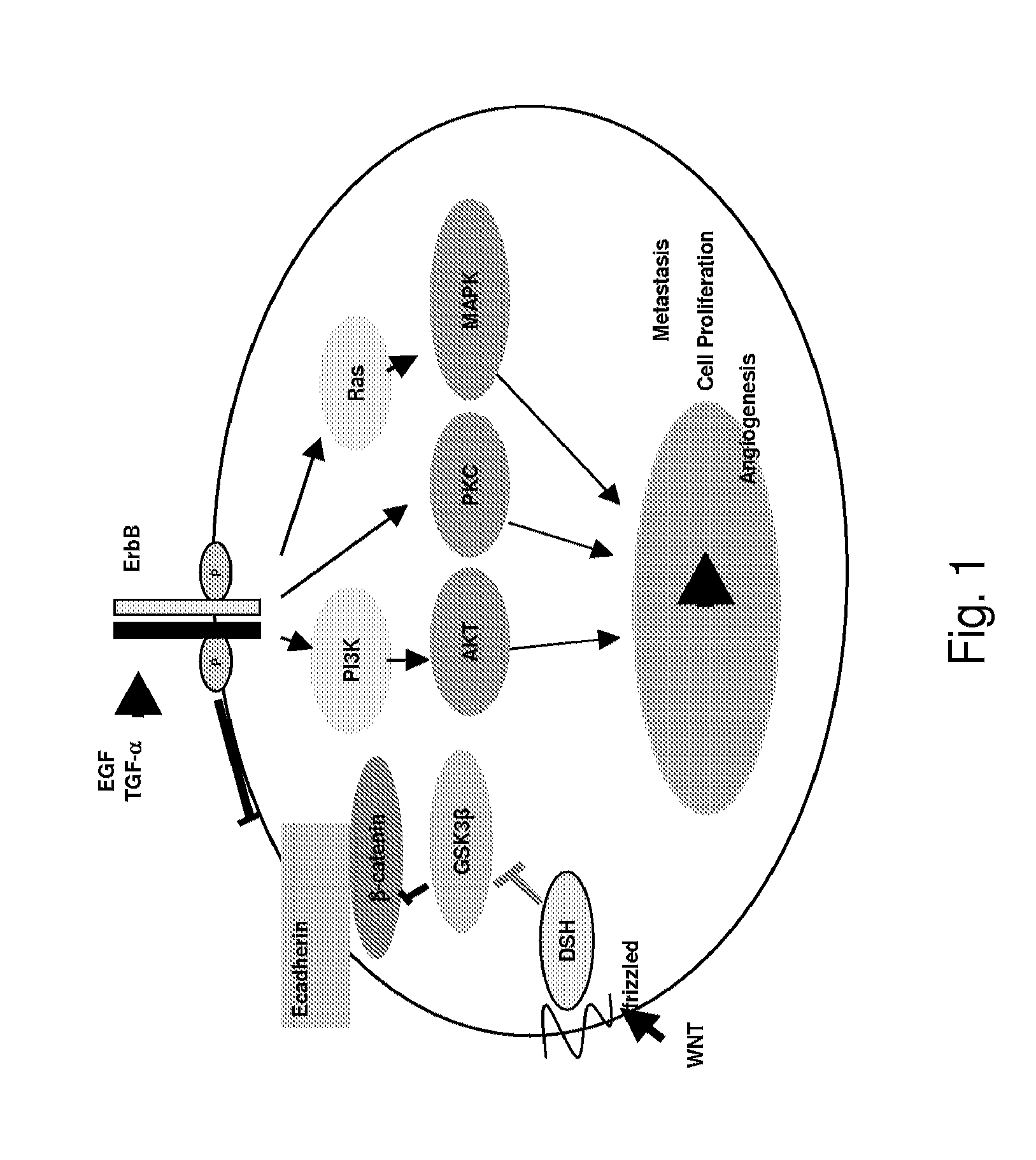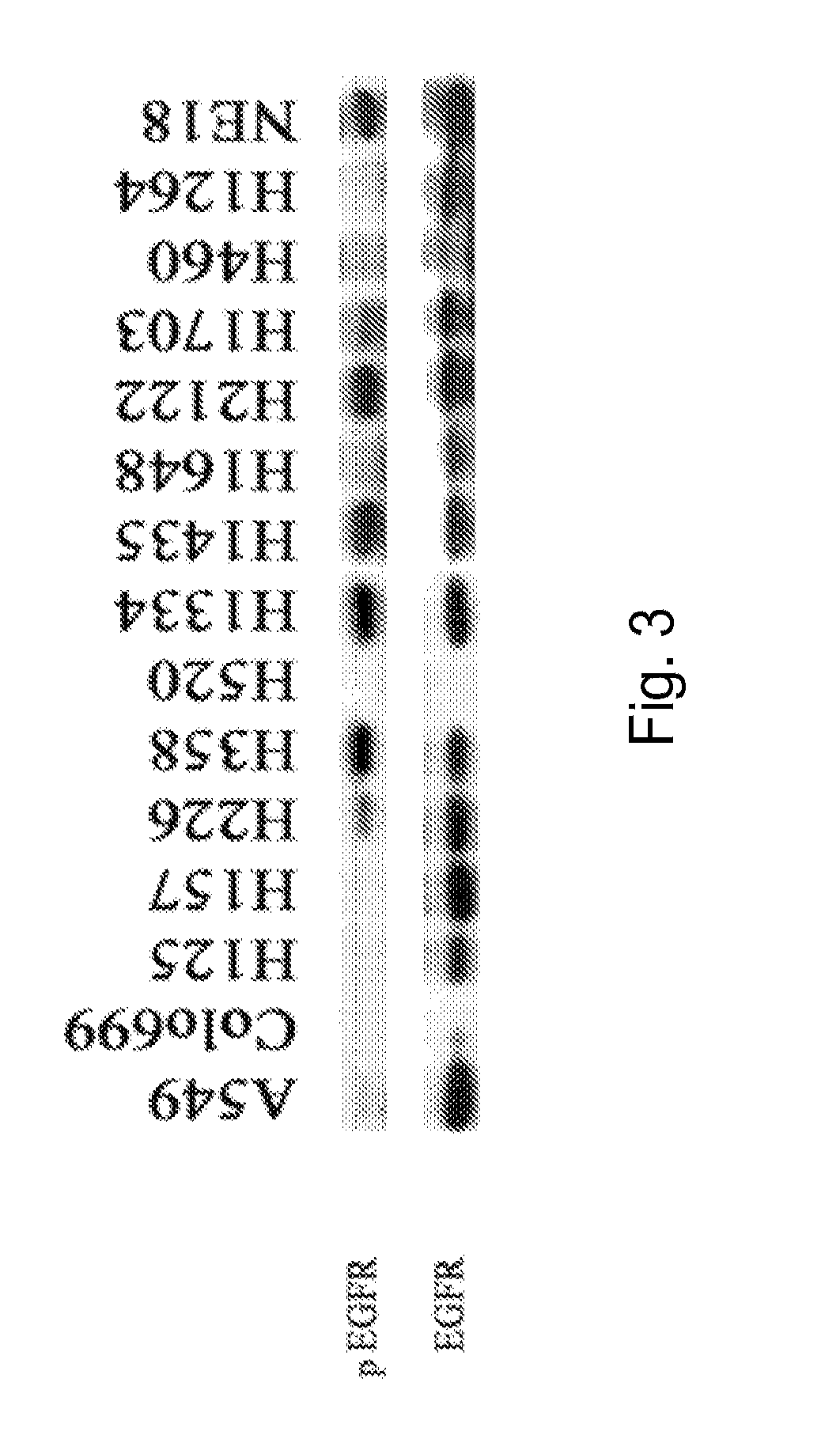Gefitnib Sensitivity-Related Gene Expression and Products and Methods Related Thereto
a technology of sensitivity and gene expression, applied in the field of gefitnib sensitivity related gene expression and products and methods related thereto, can solve the problems of poor response of bacs to conventional chemotherapy, no selection criteria for determining which nsclc patients, and less than a third of patients with advanced stages of non-small cells
- Summary
- Abstract
- Description
- Claims
- Application Information
AI Technical Summary
Problems solved by technology
Method used
Image
Examples
example 1
[0167]The following example describes the identification of a biomarker panel that discriminates EGFR inhibitor-sensitive cell lines from EGFR inhibitor-resistant cell lines.
[0168]Methods: EGFR inhibitor sensitivity is determined in 18 NSCLC cell lines using MTT assays. Cell lines are classified as EGFR inhibitor sensitive (IC5050>10 μM) or intermediate sensitivity (10 μM50>1). Oligonucleotide gene arrays (Affymetrix® Human Genome U133 set, 39,000 genes) are done on 10 cell lines. Three distinct filtration and normalization algorithms to process the expression data are used, and a list of genes is generated that is both statistically significant (unadjusted p=0.001 cutoff) and corrected for false positive occurrence. This approach is used in combination with 5 distinct machine learning algorithms used to build a test set for predictor genes that are successful for 100% of the test cases. The best discriminators (>3 fold difference in expression between sensitive and resistant cell l...
example 1a
[0171]The following example describes the identification of a biomarker panel that discriminates gefitinib-sensitive cell lines from gefitinib-resistant cell lines.
[0172]Methods: Gefitinib sensitivity was determined in 18 NSCLC cell lines using MTT assays. Cell lines were classified as gefitinib sensitive (IC5050>10 μM) or intermediate sensitivity (10 μM50>1). Oligonucleotide gene arrays (Affymetrix® Human Genome U133 set, 39,000 genes) were done on 10 cell lines. Three distinct filtration and normalization algorithms to process the expression data were used, and a list of genes were generated that were both statistically significant (unadjusted p=0.001 cutoff) and corrected for false positive occurrence. This approach was used in combination with 5 distinct machine learning algorithms used to build a test set for predictor genes that were successful for 100% of the test cases. The best discriminators (>3 fold difference in expression between sensitive and resistant cell lines) were...
example 1b
[0175]The following example describes the identification of a biomarker panel that discriminates erlotinib-sensitive cell lines from erlotinib-resistant cell lines.
[0176]Methods: Erlotinib sensitivity is determined in 18 NSCLC cell lines using MTT assays. Cell lines are classified as erlotinib sensitive (IC5050>10 μM) or intermediate sensitivity (10 μM50>1). Oligonucleotide gene arrays (Affymetrix® Human Genome U133 set, 39,000 genes) are done on 10 cell lines. Three distinct filtration and normalization algorithms to process the expression data are used, and a list of genes are generated that are both statistically significant (unadjusted p=0.001 cutoff) and corrected for false positive occurrence. This approach is used in combination with 5 distinct machine learning algorithms used to build a test set for predictor genes that are successful for 100% of the test cases. The best discriminators (>3 fold difference in expression between sensitive and resistant cell lines) are selected...
PUM
| Property | Measurement | Unit |
|---|---|---|
| melting temperatures | aaaaa | aaaaa |
| melting temperature | aaaaa | aaaaa |
| melting temperature | aaaaa | aaaaa |
Abstract
Description
Claims
Application Information
 Login to View More
Login to View More - R&D
- Intellectual Property
- Life Sciences
- Materials
- Tech Scout
- Unparalleled Data Quality
- Higher Quality Content
- 60% Fewer Hallucinations
Browse by: Latest US Patents, China's latest patents, Technical Efficacy Thesaurus, Application Domain, Technology Topic, Popular Technical Reports.
© 2025 PatSnap. All rights reserved.Legal|Privacy policy|Modern Slavery Act Transparency Statement|Sitemap|About US| Contact US: help@patsnap.com



